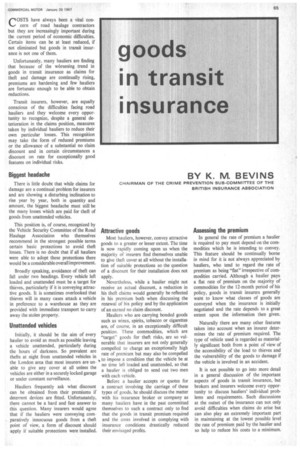BY K. M. BEVINS
Page 67

If you've noticed an error in this article please click here to report it so we can fix it.
COSTS have always been a vital concern of road haulage contractors but they are increasingly important during the current period of economic difficulties. Certain items can be at least reduced, if not eliminated but goods in transit insurance is not one of them.
Unfortunately, many hauliers are finding that because of the worsening trend in goods in transit insurance as claims for theft and damage are continually rising, premiums are hardening and few hauliers are fortunate enough to be able to obtain reductions.
Transit insurers, however, are equally conscious of the difficulties facing road hauliers and they welcome every opportunity to recognize, despite a general deterioration in the claims position, measures taken by individual hauliers to reduce their own particular losses. This recognition may take the form of reduced premiums or the allowance of a substantial no claim discount and in certain circumstances a discount on rate for exceptionally good features on individual risks.
Biggest headache
There is little doubt that while claims for damage are a continual problem for insurers and are showing a disturbing inclination to rise year by year, both in quantity and amount, the biggest headache must still be the many losses which are paid for theft of goods from unattended vehicles.
This position is, of course, recognized by the Vehicle Security Committee of the Road Haulage Association who themselves recommend in the strongest possible terms certain basic protections to avoid theft losses. There is no doubt that if all hauliers were able to adopt these protections there would be a considerable overall improvement.
Broadly speaking, avoidance of theft can fall under two headings. Every vehicle left loaded and unattended must be a target for thieves, particularly if it is conveying attractive goods. It is sometimes overlooked that thieves will in many cases attack a vehicle in preference to a warehouse as they are provided with immediate transport to carry away the stolen property.
Unattended vehicles
Initially, it should be the aim of every haulier to avoid as much as possible leaving a vehicle unattended, particularly during the hours of darkness. So prevalent are thefts at night from unattended vehicles in the London area that most insurers are unable to give any cover at all unless the vehicles are either in a securely locked garage or under constant surveillance.
Hauliers frequently ask what discount can be obtained from their premiums if deterrent devices are fitted. Unfortunately, there cannot be a hard and fast answer to this question. Many insurers would agree that if the hauliers were conveying comparatively innocuous goods from a theft point of view, a form of discount should apply if suitable protections were installed.
Attractive goods
Most hauliers, however, convey attractive goods to a greater or lesser extent. The time is now rapidly coming upon us when the majority of insurers find themselves unable to give theft cover at all without the installation of suitable protections so the question of a discount for their installation does not apply.
Nevertheless, while a haulier might not receive an actual discount, a reduction in his theft claims would generally be reflected in his premium both when discussing the renewal of his policy and by the application of an earned no claim discount.
Hauliers who are carrying bonded goods such as wines, spirits, tobacco or cigarettes are, of course, in an exceptionally difficult position. These commodities, which are "target" goods for theft risks, are so vulnerable that insurers are not only generally compelled to charge an exceptionally high rate of premium but may also be compelled to impose a condition that the vehicle be at no time left loaded and unattended, so that a haulier is obliged to send out two men with each vehicle.
Before a haulier accepts or quotes for a contract involving the carriage of these types of goods, he should discuss the matter with his insurance broker or company as many hauiiers have in the past committed themselves to such a contract only to find that the goods in transit premium required and the costs involved in complying with insurance conditions drastically reduced their envisaged profits.
Assessing the premium
In general the rate of premium a haulier is required to pay must depend on the commodities which he is intending to convey. This feature should be continually borne in mind for it is not always appreciated by hauliers, who tend to regard the rate of premium as being "flat" irrespective of commodities carried. Although a haulier pays a flat rate of premium on the majority of commodities for the 12-month period of his policy, goods in transit insurers generally want to know what classes of goods are conveyed when the insurance is initially negotiated and the rate depends to a great extent upon the information then given.
Naturally there are many other features taken into account when an insurer determines the rate of premium required. The type of vehicle used is regarded as materially significant both from a point of view of the accessibility of the load to thieves and the vulnerability of the goods to damage if the vehicle is involved in an accident.
It is not possible to go into more detail in a general discussion of the important aspects of goods in transit insurance, but brokers and insurers welcome every opportunity to discuss hauliers' individual problems and requirements. Such discussions at the outset of the insurance can not only avoid difficulties when claims do arise but can also play an extremely important part in maintaining at the lowest possibla level the rate of premium paid by the haulier and so help to reduce his costs to a minimum.




























































































































